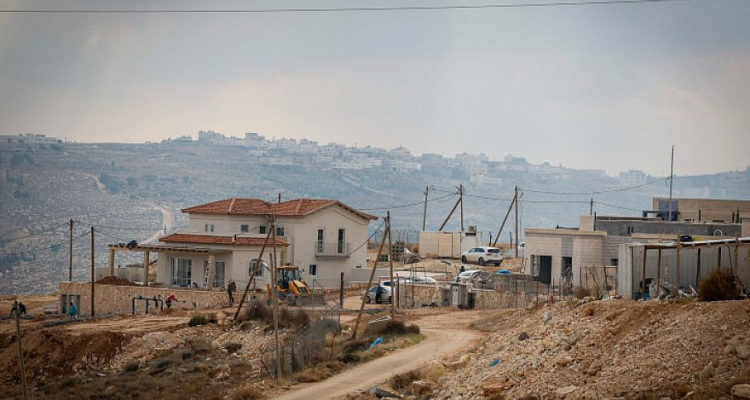Are the burgeoning Jewish population statistics in Judea and Samaria—which is now home to 12% of the country’s Jewish population—a nail in the coffin of the two-state solution?
By Judith Segaloff, JNS
Marc and Sharon Rosenbluth explored neighborhoods all over the country, but when they made aliyah, they chose to live in Karnei Shomron, a well-appointed village about 20 minutes away from Rosh HaAyin and Kfar Saba, beyond the Green Line.
“I was coming from a suburban life outside of Baltimore and I wanted my children to have a yard to play in, a basketball hoop—a similar existence,” said Sharon. “Even though we used to laugh at flocks of goats on the side of the road when visiting my brother in Karnei, we decided it was for us.”
According to Sharon, some of the reasons were financial and logistical, others ideological.
“We realized that in central Israel we would only be able to afford a closet-sized apartment instead of a house with a yard. But firstly, I’m a Zionist. I love living in Israel’s heartland.”
And she is not alone. The West Bank Jewish population statistics report puts the number of Jews in Judea and Samaria at 502,991, up from 409,493, the total representing 12% of Jews living in Israel today. This does not count the Old City and eastern areas of Jerusalem or the Golan Heights.
The statistics, compiled by Yaakov “Ketzaleh” Katz, a member of Knesset from 2009 to 2013, was sent out with a cover email with the codicil, “forward this to a friend who still thinks the two-state solution stands a chance.”
“If today we have a half million Jews, tomorrow will have 1 million,” said Ketzaleh. “We are going forward for our mission to build Eretz Yisroel. Judea and Samaria still has space for all the Jews who will decide to come to live in Israel.”
He recalls when Bet El only had seven families. Now, according to the report it is at least 8,000, although Katz believes the number is much higher, perhaps as much as 10,000 now. And Karnei Shomron’s population is 10,652 and growing.
Yitzchak Ovits was born and raised in the Shomron by parents who made aliyah. He moved with his wife and young family to Leshem, sister neighborhood of Alei Zahav, population 5,073, which soared 40% in the past year.
“Living in a yishuv, you have a neighborhood—a community,” he explains. “You know your neighbors. The children can roam on the streets on Shabbat in safety. It’s just a good quality of life. And we’re doing something—not just living the good life. We are fulfilling our Zionistic core.”
Yigal Lahav, a member of the Likud Party and Mayor of Karnei Shomron, which encompasses the neighborhoods of Maaleh Shomron, El Matan, Neve Menachem, Alonai Shiloh and Ramat Gilad, has big plans to grow his community. If things go well, he expects his populace to grow from its current 10,000 to 42,000 by 2040.
“I think we have the right government in place,” he said. “If the government doesn’t bow to American pressure, I will keep building.”
Lahav pointed out that the Shomron needs infrastructure. There is a university in Ariel, but there is no hospital to serve the half-million people who live in the Shomron, Yehuda and Binyamin.
“In Tel Aviv, for less than one million people there are three hospitals,” said Lahav. “In Jerusalem, with a population of 700,000 there are two, and Haifa has three for its population of 400,000. We deserve to be treated like a population bloc by the Israeli government. We deserve a hospital.”
Shomron Regional Council head Yossi Dagan adds, “The pioneer settlement in Yehuda and Shomron [Judea and Samaria] will continue to strengthen and grow. We are happy to see the children and the schools. We will continue to make the wilderness bloom.”
Politics and miracles
“Miracle” is a word that has been repeated by many in connection with the Judea/Samaria population boom, particularly since there has been a de facto building freeze in place for many years, according to a Gush Etzion spokesperson. The Civil Administration’s higher planning board is supposed to meet quarterly to approve the various building phases for Jews in Judea and Samaria. Under Prime Minister Naftali Bennett the meetings were perpetually delayed, keeping housing units from getting final approval. This, the government hoped, would appease the Americans and Europeans, who made no secret of the fact that they had earmarked Judea and Samaria for a future Palestinian state.
Do the burgeoning Jewish population statistics in Judea and Samaria signify a nail in the coffin of the two-state solution that the Americans and Europeans hold as conditional in their acceptance of Israel?
“The two-state solution was never feasible, and it never will be feasible,” said Naomi Linder Kahn, director of the International Division of Regavim, a public movement dedicated to the protection of Israel’s national lands and resources. The two-state “solution,” she continued, has been tried many times, and failed each time. “The idea of dividing the land from the west of the Jordan has no historical, geographical, political or security basis. It is impossible for the State of Israel to protect itself if there is any other state to the west of the Jordan river,” she noted.
“Allowing the PA, a hostile entity, that is determined to ‘liberate’ all the land from the Jordan to the Mediterranean would put the State of Israel in annihilation’s way,” she concludes.
However, Nadia Matar, who since 2011 has co-chaired the Sovereignty Movement with Yehudit Katzover, said that while “half a million people is amazing—a miracle … had we applied sovereignty from the beginning, we would have already had two million Jews here. The goal is above two million.”
After the Six-Day War, Israel should have applied sovereignty and Israeli law to the West Bank immediately, said Nadia. Instead, civil administration was handed over to COGAT, security to the army, and those who chose to build homes in Judea and Samaria were subject to land laws left over from the British, the Ottoman Empire and Jordan.
These laws stipulate, among other things, that a Muslim is not allowed to sell land to a non-Muslim. A Jew can only lease land for 50 years at a time. Only Muslims have rights to the land for agricultural purposes.
“All because the attorney general in 1967 did not want to extend Israeli law to Judea and Samaria,” explained Regavim’s Naomi.
Every 18 months Regavim takes a full aerial survey of Judea and Samaria and studies the changes. They count each structure and research its legal status. They track the infrastructure and the funding sources.
The European Union has built 100 schools in Area C, according to Naomi. They conducted spatial planning for Area C to become part of a Palestinian state, renaming streets, even in Jewish neighborhoods, with Arabic names, she said.
Regavim found 4,000 illegal structures in Jewish neighborhoods, including storage sheds and pergolas built without permits. Then they scanned the Arab areas and found 81,317 illegal structures, many of them large buildings, often strategically located to choke major traffic arteries and cut off access roads for Jews.
To preserve security for Jewish travelers, a bypass road being built behind the town of Huwara was recently blocked by an mansion that sprung up with no permits. It stymied the project, and has as yet not been taken down. International pressure to preserve the illegal building is massive, according to Naomi, but Israel needs to start demolishing illegal Arab structures, nonetheless.
“It won’t be easy,” she said. “The first few times you knock down an illegal structure there will be a lot of noise, but things will quiet down.”
Under no possible interpretation of international law is Israel doing anything illegal or that goes against international law in destroying illegal construction, she said.
“Politics are all about pressure,” explains Gidon Ariel, English speaking spokesperson for Yesha’s Gush Etzion council, citing the well-known example of the Kahn al-Ahmar Bedouin encampment that the state has not as yet demolished, despite court orders to do so. “Evidently, the pressure to once again extend the deadline to remove the Kahn al-Ahmar settlement was greater than the pressure [Israeli Prime Minister Benjamin] Netanyahu received from his coalition partners. I can say that the Likud partners all feel very strongly that it should be done.”
‘Still fighting the Six-Day War’
According to Naomi, Israel needs to wake up.
“Other countries need gas, security intelligence, help fighting terrorism, technology, and Israel has all that. We also have the support of the voters, a strong society, a strong economy, and yet we are losing hundreds of thousands of dunams of state land. This is clear discrimination. The Jews in Judea and Samaria get no rights,” she said.
She points out that while Israel closely monitors the number of Jews in Area C, it has no idea how many non-Jews are living there. Because the state never claimed ownership of the land, there is no land registry or census conducted by Israel.
“We do know that the Palestinian Authority is encouraging people from Areas A and B to stake a claim in Area C,” she said. “In fact, according to the P.A., no non-Jew has died in Area C since 1995.”
The estimates of the number of non-Jews range from 80,000 to 300,000, and there are questions about who belongs here and who came after the Oslo Accords and should not be counted in the census.
While the Jewish population statistics are a victory, it is still a fight.
“We are still fighting the Six-Day War,” asserted Nadia. “Only by declaring sovereignty in Judea and Samaria will we eliminate the question of who owns the land. It will give stability to all and ownership and responsibility to the Jews. Private residency rights and civil rights to the Arabs.”
The Sovereignty Movement has three campaigns to help wrest Judea and Samaria away from the strictures that limit it. First, they are launching a full-scale initiative to declare sovereignty over the Jordan Valley. That is the least contentious of the initiatives, as many even in the opposition support it. Second, there is a Greater Jerusalem Plan, that aims to link the city to its nearby neighborhoods, much like New York City with its five boroughs. Last is a Moving Eastward initiative. Based on research that found that the area between Hadera and Gadera is the most densely populated in Israel (even more so than the Gaza Strip), the idea is to create sovereignty which will ease the cost of housing in Gush Dan.
“The White House must take our numbers into account and understand that it is not going to be changed,” said Ketzaleh. “When I fought as a commander in the Yom Kippur war and lost my leg, I was a believer—not an optimist. Nobody can stop us. Unlike in America, here we are not assimilating. We see miracles. The reality is stronger than politics. And the trend—it’s irreversible.”
“When the Civil Administration is civilized,” said Nadia, “people are just waiting to come and live in Judea and Samaria. It is, after all, the heartland of Israel.”





